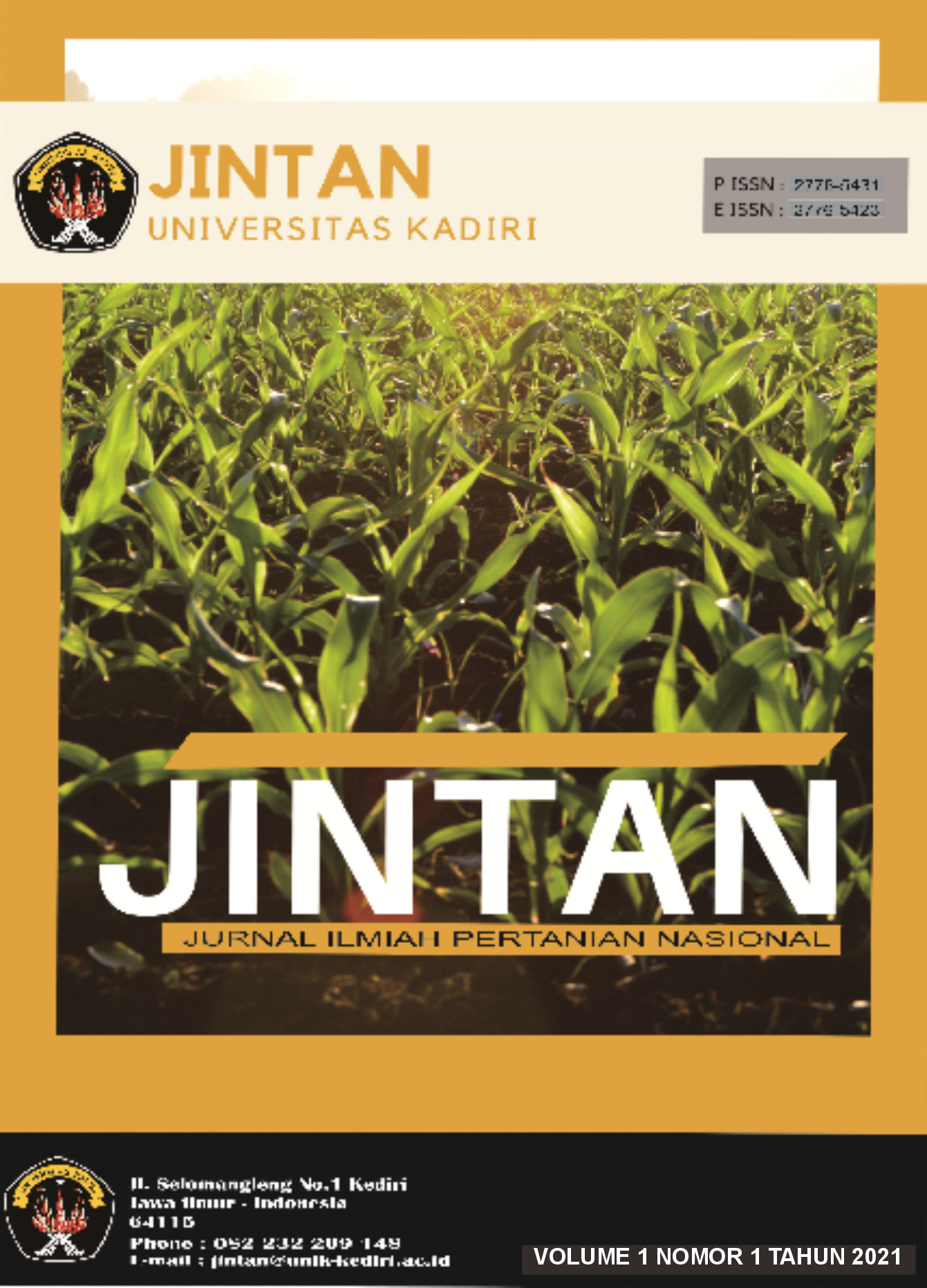Analisis Pengaruh Dosis Pupuk Urea Terhadap Produksi Padi Di Desa Cerme Kecamatan Pace Kabupaten Nganjuk
DOI:
https://doi.org/10.30737/jintan.v1i1.1392Kata Kunci:
Farmer, Paddy, Production, Urea fertilizerAbstrak
Indonesia is an agricultural country that can meet people's food needs with its agricultural products. In this case, it can be said that farmers have important roles. Cerme Village, Pace District, Nganjuk Regency, is one of the villages with the majority of the population living as rice farmers. Farmers in this area do not have sufficient knowledge about the use of fertilizers to increase rice production. Field research was carried out to analyze the effect of urea fertilizer dosage on rice production. The data used were primary data obtained from observations and direct interviews with rice farmers in the research location. Secondary data were obtained from written data at the village head office, related agencies, and existing literatures. Based on the results of the study, it can be concluded that the use of urea fertilizer has a very significant effect on rice production per hectare in Cerme Village, Pace District, Nganjuk Regency.
Â
Indonesia merupakan negara agraris yang dapat memenuhi kebutuhan pangan masyarakat dengan hasil pertanian yang dimiliki. Dalam hal ini, dapat dikatakan bahwa petani mempunyai peran yang sangat penting. Desa Cerme Kecamatan Pace Kabupaten Nganjuk merupakan salah satu desa dengan mayoritas penduduk bermatapencaharian sebagai petani padi. Petani di wilayah ini belum memiliki pengetahuan yang cukup mengenai penggunaan pupuk untuk meningkat produksi padi. Penelitian lapangan dilaksanakan untuk menganalisis pengaruh dosis pupuk urea pada produksi padi. Data yang digunakan adalah data primer yang diperoleh dari hasil observasi dan wawancara langsung terhadap petani padi di lokasi penelitian. Data sekunder diperoleh dari data tertulis pada kantor kepala desa, instansi terkait, dan literatur yang ada. Berdasarkan hasil penelitian dapat disimpulkan bahwa penggunaan pupuk urea berpengaruh sangat nyata terhadap produksi padi per hektar di Desa Cerme Kecamatan Pace Kabupaten Nganjuk.
Referensi
Artini, W. (2017). Kebutuhan Petani Untuk Pengembangan Usahatani Padi Organik (Studi Kasus Terhadap Kelompok Petani Padi Organik di Kabupaten Kediri). Agrinika, 1(1), 12–26.
Artini, W., & Rusmanto, E. (2017). Ragam Konsumsi Pangan Masyarakat Pedesaan Di Desa Margopatut Kecamatan Sawahan Kabupaten Nganjuk. Agrinika, 1(1), 27–43. https://doi.org/10.1017/CBO9781107415324.004
Barokah, U., & Susanto, U. (2020). Respon Berbagai Varietas Padi pada Lahan Organik dengan System of Rice Intensification (SRI) di Sragen. Jurnal Agrinika: Jurnal Agroteknologi Dan Agribisnis, 4(2), 130. https://doi.org/10.30737/agrinika.v4 i2.1065
Bayu Aji, S., Sutiknjo, T. D., & Dinawati, E. (2020).Peranan Penyuluh Pertanian Terhadap Keberhasilan Penerepan Sistem Tanam Padi Jajar Legowo di Desa Pagung Kecamatan Semen Kabupaten Kediri. Jurnal Agrinika: Jurnal Agroteknologi Dan Agribisnis, 4(2), 197. https://doi.org/10.30737/agrinika.v4 i2.1075
Junaidi, & Harminto. (2018). Usaha Peningkatan Produksi Padi (Oryza Sativa L) Dengan Penambahan N Pada Perlakuan Dosis Pupuk Kandang. Agrinika, 2(1), 41–53. https://doi.org/10.1017/CBO978110 7415324.004
Miles, M. B., & Huberman, M. A. (2012). Analisis Data Kualitatif: Buku Sumber Tentang Metode-Metode Baru. UI Press.
Sidhi, E. Y., & Syafi’i, M. L. (2017). Analisis Proyeksi Kebutuhan Beras Berdasarkan Perkembangan Jumlah Penduduk (Studi Kasus di Desa Blimbing Kecamatan Gurah Kabupaten Kediri). Jurnal Agrinika : Jurnal Agroteknologi Dan Agribisnis, 1(2), 127–141.
Sugiyono. (2016). Metode Penelitian Kuantitatif, Kualitatif, dan R&D. CV. Alfabeta.
Suharyanto, S., Rinaldy, J., & Ngurah Arya, N. (2015). Analisis Risiko Produksi Usahatani Padi Sawah. AGRARIS: Journal of Agribusiness and Rural Development Research, 1(2), 70–77. https://doi.org/10.18196/agr.1210
Supandji, S., & Junaidi, J. (2019). Pengaruh Pupuk Urea Dan Pupuk Organik Sapi Terhadap Pertumbuhan Dan Produksi Tanaman Padi Varietas Ir. 64 (Oryza sativa L). Jurnal Agrinika : Jurnal Agroteknologi Dan Agribisnis, 3(2), 107–119. https://doi.org/10.30737/agrinika.v3 i2.727
Tinaprilla, N., Kusnadi, N., Sanim, B., & Hakim, D. B. (2013). Analisis Efisiensi Teknis Usahatani Padi Di Jawa Barat Indonesia. AGRIBUSINESS JOURNAL, 7(1), 15–34. https://doi.org/10.15408/aj.v7i1.516 8
Wahyunindyawati. (2009). Pengaruh Faktor-Faktor Produksi Terhadap Keuntungan Usahatani Padi. Balai Pengkajian Teknologi Pertanian Jawa Timur.
Unduhan
Diterbitkan
Cara Mengutip
Terbitan
Bagian
Lisensi
Authors who publish in this journal agree to the following terms:
- Authors retain copyright and grant the journal right of first publication with the work simultaneously licensed under a Creative Commons Attribution License (https://creativecommons.org/licenses/by-nc-nd/4.0/) that allows others to share the work with an acknowledgment of the work's authorship and initial publication in this journal. Permitted third party reuse is defined by the Creative Commons Attribution-NonCommercial-NoDerivs (CC BY-NC-ND). This permission allows users to copy and distribute the Article, provided this is not done for commercial purposes and further does not permit distribution of the Article if it is changed or edited in any way, and provided the user gives appropriate credit (with a link to the formal publication through the relevant DOI), provides a link to the license, and that the licensor is not represented as endorsing the use made of the work.
- Authors are able to enter into separate, additional contractual arrangements for the non-exclusive distribution of the journal's published version of the work (e.g., post it to an institutional repository or publish it in a book), with an acknowledgment of its initial publication in this journal.
- Authors are permitted and encouraged to post their work online (e.g., in institutional repositories or on their website) prior to and during the submission process, as it can lead to productive exchanges, as well as earlier and greater citation of published work.
- For open-access publishing, authors have the right to share their articles in the same ways permitted to third parties under the relevant user license, as well as certain scholarly usage rights.




